Ta
Dzong is Paro's only Museum.
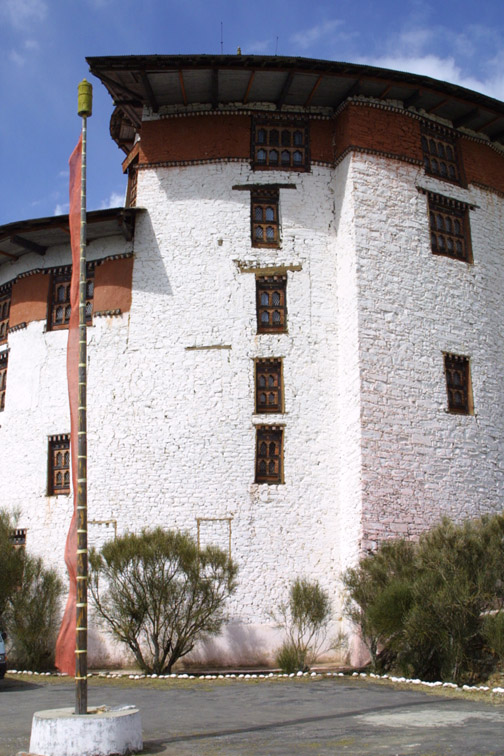
It is a
museum of history and does a great job of introducing strangers
to the Bhutanese world. No pictures are allowed inside, OK,
so you have to go there, or buy some book from Amazon.com if
you want to see the cool stuff I saw but I can briefly tell
you about it.
There is
a dragon painted on the wall of the first floor which exactly
resembles one our boatmate Sophia painted in the Vallejo bathroom.
The word Bhutan means "Land of the Thunder Dragon"
which is derived from the storms that sweep down the Himalayas.
The building
is round and has 7 stories. Use to be a fortress. It houses
armour and weapons that to the untrained eye of Heide Foley
kinda look like Medival Europe stuff.
Four Friends
Another familiar picture, "Four Friends"- the elephant,
the monkey, the rabit and the bird - is found on the 2nd floor.
I first heard the story of the four friends in Mongolia. It
changes a bit in Bhutan but the gist is still of 'cooperation.'
One of the four animals has seeds and they all help plant and
caring and a tree grows. But the tree grows very tall and the
fruit is too high for any single one of them to reach so they
pyramid on eachother's back and are able to reach the fruits
and share the harvests. The imagery of this story is on almost
every public building.
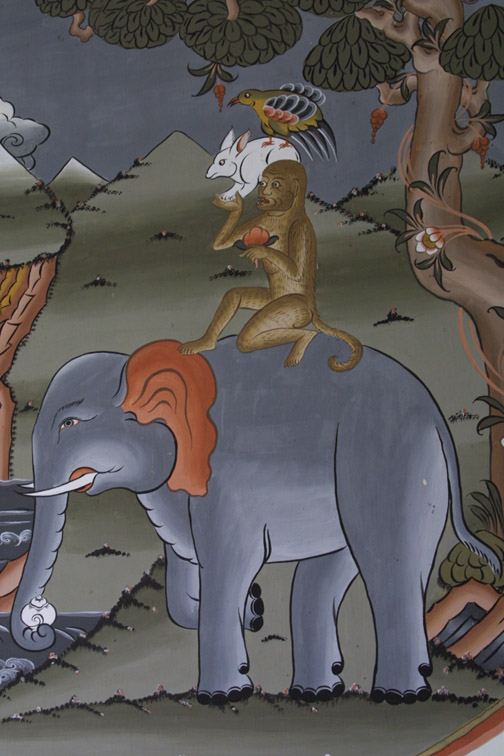
Rituals
The enclave in the museum with Buddhist ritual objects was very
modest. This is all new stuff to me and I couldn't takle photos,
but I did note a vajra (also called a thunderbolt and amoung
other things represents the penis), a tingsha, crafted metal
rice containers, yak butter lamps which look like bowls on stands,
and color coded scarfs which denote rank and are worn to Court
and offical things. Greenish for king and highest priest, red
for religious men, white for commoners.
| Varja
|
Tingsh |
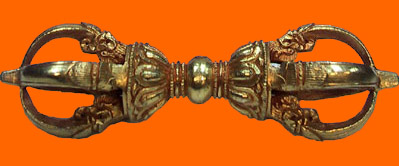 |
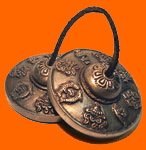 |
Foot
impressions
Buddhism was imported, after it arrived in Tibet, and the man
who is famed for it's spread, Guru Rinpoche, is revered and
they have an aweful lot of statues and pictures of him. Reincarnation
of famous lamas is a very important belief in Bhutan and indeed
so many times I was told, "Yes, he is a reincarnation"
when I ask about anyone who was remotely famous.
The
museum also houses lots of foot impressions. Usually only one
foot, not both. I can't recall if it was the left or right foot
and they didn't sell postcards of any of them the day I was
there.
Buddha Room
On the 5th floor there is a chapel - a round room with wall
to wall cubes of buddha statues and a few other dieties, too,
all facing an alter in the middle. We learn to walk around the
alter clockwise and in odd numbers, usually three times, and
never in even numbers. The room has gold glit and red paint,
a little carving, and lots of faux painted symbolism. It seems
to have an antiquity about it but I wondered and wasn't sure.
The focus of it draws all your thoughts to the pantheon of these
gods. On that floor outside the chapel the catwalk around the
edge takes you past about 40 hanging thangksas. Is seems pretty
much all imagery in Bhutan is religious. Yet a cool graphic
of the geometry of the Thangkas showed an underlying attention
to realtiy.
Stairs
Stairs in Bhutan are not standardized. They tend to be steeper
then most, not always uniform and the steps are more narrow
than the foot. Patrica in our group is over 60 ( may be over
70) and sh was not impressed. Of course, impressing Pat is not
easy. I did not get to go on the HRH trip down the Nile in Egypt
last year and Pat told me, "I don't think you missed much."
3-D Mandal
On the top floor is another chapel (tshogshing) but with a three
dimensional Mandala in the middle of it. You take off your shoes
before entering. It was cold here and dim. The roof was very
low so we had to bend a little. I could see my breath. The only
light came from a slit window and seven bowls with wicks on
one side of the 3-D alter. A group of young girls came in just
after us. They all bowed and put $10s and $20s ngultrums in
a bowl on each of the four sides of the huge sculpture. They
walked clockwisde and at each side put their hands together
above the head and touched them to their forhead, mouth, chest
and in a graceful flow tucked in the long traditional skirt
to the back of their knees as they kneeled to the ground. The
oldest girl had to urge the others on not to be shy and to continue
even with all of us white skinned adults watching. Her fabric
made the loudest sound as her hands raced down her sides and
quickly, abruptly pulled her skirt folds up to the back of her
knee as she knelt to the floor. It was lovely. They all wore
bright colors. Varda would have LOVED the fabrics!
Forced
Dress
Bhutan has a law enforcing traditional dress during business
hours and the locals all wear colorful patterns. The men's short
kimo type cloaks come to the knee and are assessorized with
knee-high socks. At first I thought it cute in a silly way,
but then I couldn't help but notice the occassional kneecap,
and the suggestive way the 'robe' rests across the lap while
they are sitting. It took on a whole new meaning. The women
wear full length skirts and a double layered blouse held closed
in the front with a broche. The sleeves of both sexes are super
long, like twice arms lenght, and they fold them up into big
cuffs.
Yes,
I Don't, No
Usually when I arrive to a new destination I walk around, met
a few locals, read a bit of it's history and arrive at a feeling
for the place. Bangkok is dynamic, Tonga is mellow, the USA
is energic, etc. But I am not sure what I feel about Bhutan?
The people seem stable and serene. They deal with emotion on
the level that it simpy 'is' and go on knowing no matter how
big something is, there is it's balance at the other extreme.
It made me realized a place, a collective, must have extemes
on both sides if all are to have balance.
I ask my
guide in Bhutan, Robin, who has been in tourism in Bhutan since
it's beginning in1974, about the influence of Western culture?
He says that as he understands it, youth have no responsibilities
and they therefore can be readily influenced by Western culture.
But once they are of age, once they have to 'provide' for their
families, they change. Traditional ways become important. "Of
course some drop off," he grins at me in a kind, understanding
way, "that is their Karma."
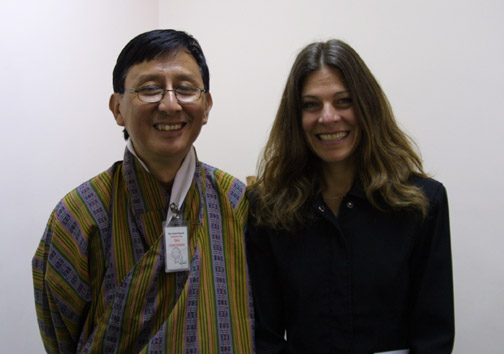
Robin believes
that one of the best promotions for retaining the traditional
values of his country is when locals travel to foreign places.
Even the Bhutanese who study abroad all come back. He believes
they realize how special Bhutan is, and prefer it.
Gross
National Happiness
I could be wrong, but I think Bhutan is the only country in
the world with an official GNH (Gross National Happiness). It
is also the last place in the world to have Tantric Bhuddism
- which espouses that samsara is nirvana and indulges in worldly
pleasures - as an official religion. But their brand of Buddhism
is not to be taken as a free rein to excess and abuse. "If
you can't help yourself, who can help you?" asks the King's
brother. In their reality the concensual hallucienation expects
all people to be good. How many people in the rest of the world
really and truly trust their neighgors?
The truth
is Bhutan is small. Everyone knows everyone. Cities and villages
are scattered in the gorges of the fucking huge and daunting
Himalayas and life is difficult. The pressures to doing the
right thing hold the kingdom in balance. "You just don't
do crazy things for long," Robin laughs, "because
someone is going to say to you - Hey, cut it out!"
2 Hour
Drive to Thimphu
It is late in the day, the sun is about to go down and we are
in a 6 seater people mover swirling around corners on the very
windy roads. The driver honks at approriate times to warn oncoming
traffic around particaularly dangerous bends that we are about
to emerge in front of them. It is very affective, lke a friendly
little toot hello. Constantly below us is the fast waters of
the river. The house are in traditional style, the fields are
terraced, the mountains are magestic. Our guide mentioned the
importance of the phallic symbol on he houses (a huge penis
and hairyballs) obviously as fertility signs, but he didn't
contribute anything about the unobvious. He only added that
airplanes are also commonly painted on the four corners of the
hous to ward off evil. Airplanes?
|